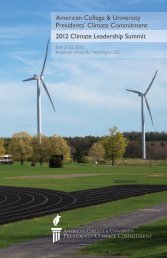ACUPCC 2009 Annual Report - Climate Commitment
ACUPCC 2009 Annual Report - Climate Commitment
ACUPCC 2009 Annual Report - Climate Commitment
Create successful ePaper yourself
Turn your PDF publications into a flip-book with our unique Google optimized e-Paper software.
Success Stories<br />
Acupcc school innovations<br />
Green Building and Renovation<br />
Ithaca College, Ithaca, NY<br />
President: Thomas R. Rochon • Implementation Liaison: Carl Sgrecci, Vice President of Finance and Administration<br />
Ithaca College recently dedicated our new Peggy Ryan Williams Center. This 58,000 square foot building features a large atrium<br />
overlooking Cayuga Lake and a multipurpose auditorium for admissions presentations. This spectacular facility was designed to<br />
achieve platinum LEED certification. Over 50% of the building’s energy comes from renewable sources, including a geothermal<br />
system to provide heating and cooling. Other sustainable features include: nearly 6,500 square feet of vegetated roof area; natural<br />
convection ventilation that draws cooled night air across a shade garden and relieves it out the four-story light monitor; lighting<br />
controlled by daylight and occupancy sensors and mechanical ventilation systems that reduce energy by automatically responding to<br />
ambient conditions; and a 12,000-gallon tank that collects rainwater for toilet flushing, meeting over 85% of the building’s yearly<br />
water needs. The building is located adjacent to the LEED Platinum-certified Park Center for Business and Sustainable Enterprise,<br />
which opened in 2008.<br />
University of Maryland Eastern Shore, Princess Anne, MD<br />
President: Thelma B. Thompson<br />
Implementation Liaison: Maurice Ngwaba, Assistant to the Vice President of Administration and Facilities<br />
The University of Maryland Eastern Shore (UMES), Maryland’s only Historically Black Land Grant University, has prioritized green<br />
building and renovation. By the spring of 2010, UMES will construct a 20-acre photovoltaic solar farm on our campus that will<br />
generate about 2.2 megawatts of clean electricity. This SunEdison construction will be the largest renewable energy project in<br />
Maryland and will provide UMES with long-term, predictably priced solar-generated energy. UMES’ ten-year plan will reduce the<br />
amount of energy used across the campus by more than 20 percent per year from 2005 levels.<br />
We are committed to a minimum Leadership in Energy and Environmental Design (LEED) Silver Rating for our major capital<br />
projects. In the renovation of two campus buildings, the university used a geothermal system to generate heating and cooling in a<br />
residence hall and began a separate $7.2M project designed and constructed to meet LEED Silver Rating. To achieve this goal,<br />
facilities staff members have become certified as LEED Accredited Professionals and are working with other professionals across the<br />
University System to ensure that required LEED rated facilities are constructed. To connect sustainable building with sustainability<br />
education, we’re developing new courses in green building concepts in the Construction Management Technology department.<br />
Utah State University, Logan, UT<br />
President: Stan L. Albrecht • Implementation Liaison: Nat Frazer, Dean of the College of Natural Resources<br />
In June <strong>2009</strong>, our Wetland Discovery Point building at the Utah Botanical Center was awarded Platinum LEED certification. Its roof<br />
functions as both a rainwater collector and a tool to provide shade or allow winter sunlight into the building to warm it and provide<br />
abundant natural light. Harvested precipitation is stored in a cistern and used to irrigate part of the landscape and to flush low-flow<br />
toilets. Much of the power used in the building is solar generated, and solar-heated water flows through the building’s heating<br />
system. Extensive use of windows connects visitors with the landscape and improves ventilation.<br />
Not only is the building’s design sustainable, but the facility is also used as an educational site where adults and thousands of school<br />
children come to learn about the importance of conservation and wetland ecosystems, and about how they can implement green<br />
practices into their homes and lifestyles.<br />
<strong>ACUPCC</strong> <strong>2009</strong> <strong>Annual</strong> <strong>Report</strong> 10





